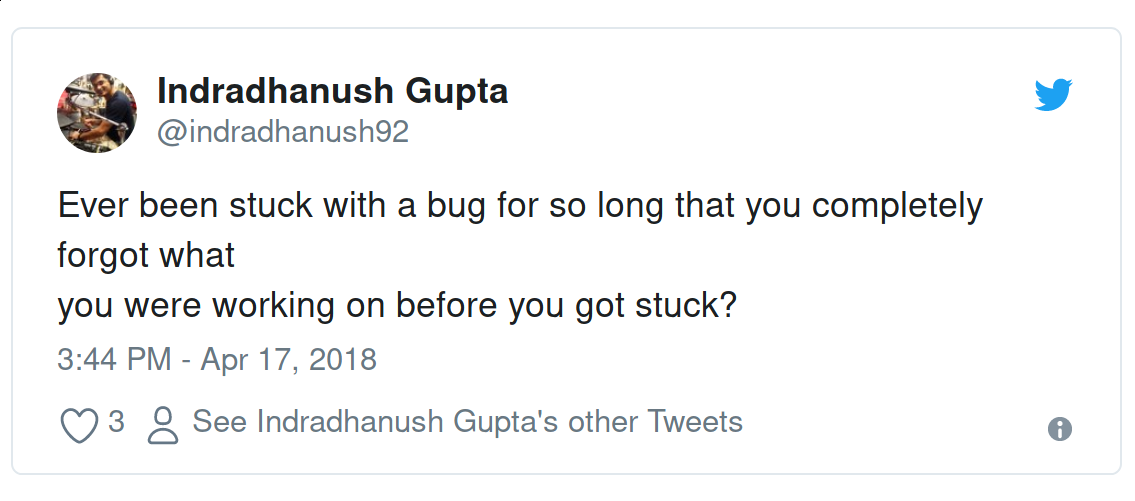I’ve been working on a Kubernetes service broker at work, specifically the Habitat service broker. To put it mildly without diving deep into the details, the Habitat service broker is an OSB compliant piece of software whose job is to run apps built with Habitat in a Kubernetes cluster. The service broker is deployed via Helm, which is a package manager for Kubernetes. What each of these are built for is not exactly important as is the debugging story that I’m about to describe. Let’s reserve that for a future post(s).
I had reached a checkpoint of sorts where I was able to successfully create and apply a custom configuration on a redis instance that was provisioned via the broker in the Kubernetes cluster. Once the pull request was merged, I started working on another feature that was to undo this custom configuration. This required me to tinker with the RBAC rules, which is an authorization mode available in Kubernetes. I had to add new rules for accessing additional API endpoints. After writing the code for this and trying to apply the change on my cluster for the first time, I started seeing an error that looked like this:
Error: release habitat-service-broker failed: clusterroles.rbac.authorization.k8s.io "habitat-service-broker-habitat-service-broker" already exists
make: *** [Makefile:35: deploy-helm] Error 1
Even if someone has no experience in Kubernetes, it should be
relatively straightforward to understand this error at a higher level,
which is that my code is trying to create a resource named
“habitat-service-broker-habitat-service-broker” and failed since it
already exists in the cluster. To elaborate on the error a little, I
am trying to create a new clusterrole object via Helm, our protagonist
of this story.
My first instinct was that there was something stale lying around on my Kubernetes cluster from my previous testing and starting on a fresh cluster would fix it. No surprises there that starting a new cluster did not fix the bug. I was running my cluster via minikube, which is a tool to run Kubernetes clusters locally. After a lot of tinkering and without any success I shared a set of instructions to reproduce the bug with my colleagues. But surprisingly the code was working fine for them without any signs of the bug. At this point I thought that there was something wrong with my minikube setup or that it had some other configurations that I didn’t know about.
I decided to use kube-spawn which is another tool to quickly setup a Kubernetes cluster but with some differences than minikube (you can read more about it here). However this bug seemed to be omnipresent and it showed up on the kube-spawn cluster as well. By this point I had spent more than two days on this bug and was beginning to be think that this was something sillier than expected.
Helm, like we mentioned previously is a package manager for Kubernetes
and uses “charts” for defining services and their properties. The RBAC
related changes are also part of the charts and is defined using
yaml files.
Not knowing where to look next, I asked my colleagues Iago and Lorenzo
to pair with me on this and I set upon to reproduce the bug from
scratch. During the pairing session, they asked to look at the file
that contained the clusterrole definition.
Here’s what the corresponding directory looked like:[1]
$ tree $PROJECT_ROOT/charts/habitat-service-broker/templates/
charts/habitat-service-broker/templates/
├── broker-deployment.yaml
├── broker-service.yaml
├── broker.yaml
├── clusterrolebinding.yaml
├── #clusterrole.yaml#
├── clusterrole.yaml
├── _helpers.tpl
└── serviceaccount.yaml
0 directories, 8 filesNotice the odd file starting and ending with a #? That’s an Emacs
buffer for the original file named clusterrole.yaml. It turns out
that Helm, picks up all files that “look like” yaml from the charts
directory. As a result it was first applying the contents of
clusterrole.yaml and then those of #clusterrole.yaml#, or the
other way round. Either way, when it got to the second file that’s
when the command would fail. Emacs buffers normally get deleted when a
file is saved, and this might have been leftaround from a crashed
Emacs session. Deleting this buffer fixed the bug.
I felt a mixture of emotions at this point: anger, stupidity, agitation, happiness and relief. It took me sometime to get back to my original problem statement though.
I was stuck with this for more than two days and was eventually able to fix it over a ten minute video call thanks to my colleagues. Even though I found Helm’s approach to dealing with template files a bit silly, I learned (and relearned) the following things out of this experience:
- I should configure my editor to store buffers outside my working directory.
- An extra pair of eyes is always a great idea.
- If you’re stuck seeing the same error for a long enough time, ask for help sooner rather than later. Although a different error from your last one can be thought of as progress. This is especially relevant if you’re worried about asking for help “too much”.
- If an error cannot be reproduced on someone else’s machine it becomes much harder for others to help you unless you invite them over to your machine.
- If a bug sounds like a simple oversight somewhere rather than something obscure and non trivial, it probably is.
That’s all for now, thanks for reading and I’ll let you enjoy this xkcd comic for now:

Footnotes:
[1]: I used Emacs for navigating the directory, but I used tree
here for better representation.

